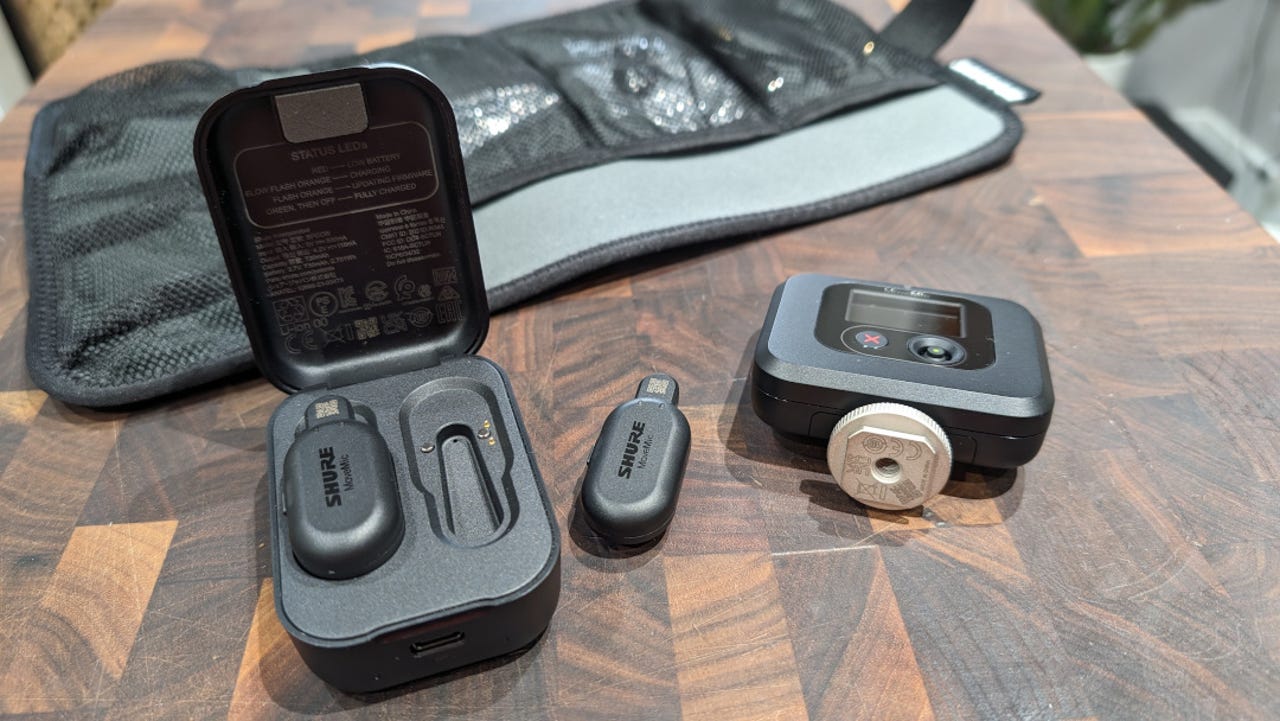
The MoveMic Wireless Lavalier system punches way above its weight. ZDNET/Jack Wallen
ZDNET’s key takeaways
- The Shure MoveMic Wireless Lavalier mic system is available now, either purchased as a kit (with mics and receiver, or as individual pieces).
- Brilliant sound, easy setup, and the receiver menu is a treat to use.
- Note that the range is limited to around 100 feet. That should still be far enough for most users.
Shure has been in the audio business for a long time. I’ve used so many Shure mics over the years that I couldn’t even begin to count them. But when it comes to lavalier mics, I’ve been using a pair of Sony UWP-D21 mics with brilliant results. I connect them to my ZCAM E2 F6 cinematic camera knowing I can count on them every step of the way.
Also: The best streaming mics of 2024 for TikTok, YouTube, and Twitch
But what about when I don’t have my Sony mics or my main camera? What about if I’m out and about and need to film an interview or some other moment and all I have is my phone? That’s when the new Shure MoveMic wireless lapel mic system shines.
This newly released wireless lavalier mic makes it possible to capture professional-level audio on mobile phones, cameras, or computers. The small, wireless, clip-on mic connects to a receiver, which you then connect to your device, and gives you 24 hours of recording time on a single charge (eight hours from the mic and an additional 16 from the charger).
I tested the MoveMic on three different devices:
- Sony Alpha 7 III
- ZCAM E2 F6
- Pixel 8 Pro
For the review, I was sent the MoveMic Two Receiver Kit, which included the receiver and two lapel mics. This setup runs $499.00. You can buy the components separately as such:
- MoveMic Receiver – $199.00
- MoveMic One – $249.00
- MoveMic Two – $349.00
- MoveMic Two Receiver Kit (what I reviewed) – $499.00
The specs
As far as specifications are concerned, here are the highlights:
- Two-channel wireless mic system
- Eight hours of recording time from a full charge on the mic and an additional 24 hours of recording time from the charging case
- Instant setup and connectivity
- Direct-to-device wireless (with the Sure MOTIV) app, or using the MoveMic Receiver
- Custom acoustic design
- Customizable audio, including gain, EQ limiter, noise reduction, high pass, and compressor
- Rated IPX4
- 50Hz to 20kHZ frequency range
- Tolerance of +/- 1dB
- 3.5 mm audio out, 3.5 mm headphone jack, and USB-A port on the receiver
My experience
My first test was with the ZCAM, where I assumed the gain was set at an average level. After a quick five-minute test, I moved the drive to my iMac, connected it, and watched the video, only to find the audio highly distorted.
I then decided to do an even quicker test with my Pixel 8 Pro. I plugged the receiver into the phone (via an included USB-C cable), opened the camera, and began filming. After a couple of minutes, I stopped recording and played it back to find the audio was outstanding.
Also: My go-to microphone for podcasting and streaming over the past decade
With my camera, I ran through the easy-to-use menu system — and I do mean easy, which is a relief — and took the gain down from the default, which I believe was 40dB, to 5dB. Another quick test and I was surprised to find the audio was almost as good as from my Sony mics (which, for two mics and two receivers, cost almost three times the price of the Shure MoveMic system that I had tested).
The biggest difference between the two systems is range. The Sony mics have a massive range. I’ve walked all over our 3,000 square-foot house, in every room, and the Sony mics didn’t miss a beat. I’ve watched video tests where the speaker walked far enough away that they were hard to make out, yet could still be heard.
As for the Shure MoveMic, the range is roughly 100 feet. Now, that’s perfectly fine. Chances are that you’ll never need the range that comes with the Sony mics.
Also: DJI’s latest wireless microphones solve one of my biggest problems
Also, the Sony mics do have a bit more depth to their sound, but that could be because they are traditional lav mics that can be taped to the inside of a shirt, which benefit from gaining a bit of resonance from the chest. The Shure MoveMics are clip-on mics that don’t benefit from resonance and are also a bit harder to hide. That’s okay for interviews, but if you’re doing any sort of narrative work, you’ll have to get creative to hide the mic from sight and still retain the high-quality sound.
One area where the Shure mics rise above Sony’s is EQ. The Sony mics have no EQ settings, whereas the Shure mics give you a five-band EQ (ranging from 100Hz to 10kHz) that can help overcome the lack of resonance you might not get from placement. With the slightest tweak to the EQ, the Shure MoveMic sound was rich, clear, and dynamic.
ZDNET’s buying advice
Caveats aside, the Shure MoveMic seriously impressed me — after I resolved the gain issue. Although I wouldn’t replace my Sony mics with this kit, I would absolutely use these for on-the-go interviews or other instances when I need an extra pair of mics. And given the price is considerably lower than the Sony mics, the Shure MoveMic is a no-brainer for those looking to up their audio game for video.

